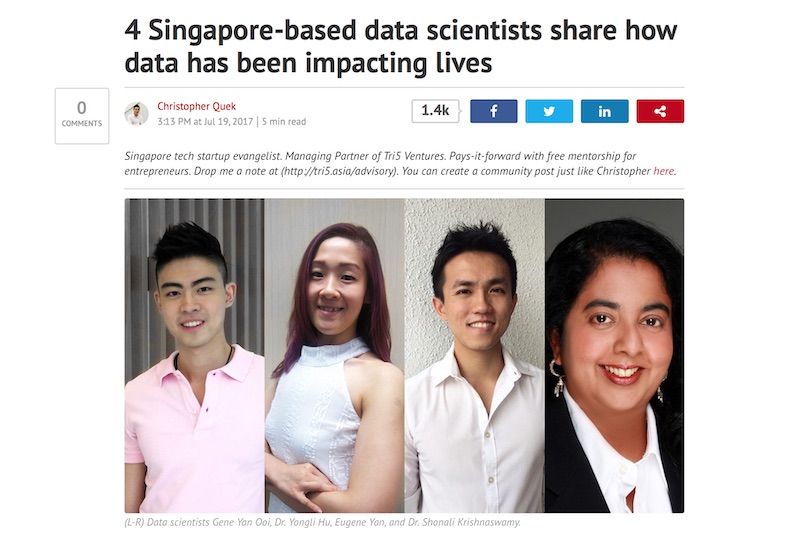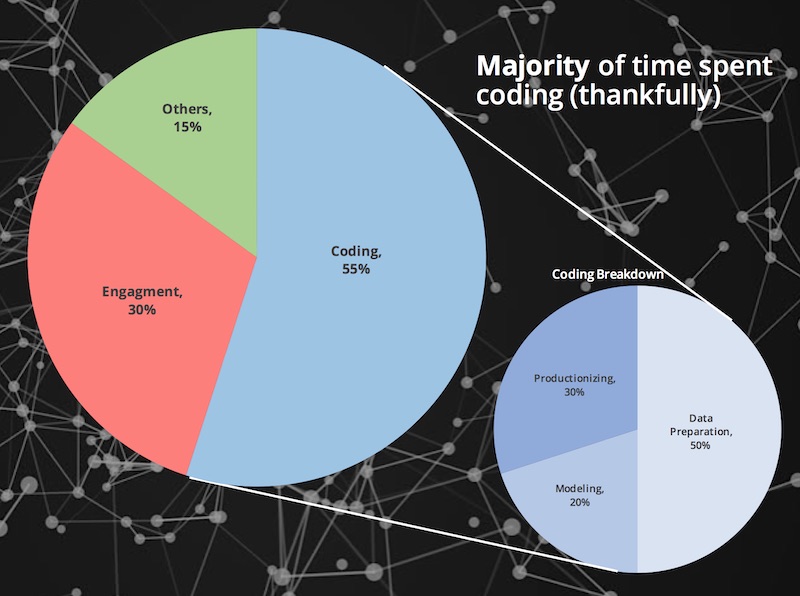Tech in Asia - My Journey in Data Science and Advice for others
Recently, Christopher, Managing Partner at Tri5 Ventures, reached out for an interview about “The Life of a Data Scientist”. The intent is to share knowledge and insight with people aspiring to enter the field, or those currently practicing data science.

The article was published a week ago on Tech in Asia and can be found here: “4 Singapore-based data scientists share how data has been impacting lives”. It covers data science professionals across multiple backgrounds, including researchers, entrepreneurs, and startups.
A few people have asked if I could build on what was shared in the article, so I’m reproducing my complete responses to Christopher here.
What made you decide to pursue a career in data science?
TL; DR: My interest in understanding human perception and behaviour led me to pursue psychology, statistics, and machine learning. With these skills, I joined Lazada’s Data Science team in 2015.
Wow, I can’t remember the last time being asked this.
Since my undergrad days (when I was pursuing psychology and statistics), I’ve been interested in how people perceive, think, and behave. This required measuring perception (surveys, etc), behaviour (actions, etc), and outcomes, and making inference. In other words, data and statistics.
I then got an opportunity to apply this in IBM’s Workforce Analytics team, where we built an internal job recommendation engine for employees and tracked outcomes. The goal was to help people level up in their careers, improve job engagement and performance, and reduce attrition.
Along the way, I gained an interest and picked up machine learning. Statistics helps us to understand historical data and make inferences; Machine learning helps us learn from historical data and make predictions.
I then got an opportunity to join Lazada’s data science team in 2015, thanks to Kai Xin and John. I’m not exactly sure when my career in data science started, but I guess joining Lazada Data Science might have been it.
What are 1-2 myths of data science that needs to broken?
Myth: Machine learning is 80% of the work (is this a cliché myth?)
Truth: Machine learning is about 20%.
- About 50% is data understanding, exploration, cleaning, preparation, feature engineering.
- Another 30% of the time is building a POC, validation/AB testing, developing an API, deployment, etc.
Note: The above breakdown is unique to each data scientist, but it’s roughly how my time is spent.
Myth: I (only) need to be a technical rockstar.
Truth: Being a technical rockstar helps, especially with what I’ve listed above—but it’s not enough to really make an impact. You also need to be able to:
- Identify and understand problems deeply (what is the root cause? are we only fixing the symptoms?)
- Design end-to-end solutions (it doesn’t help if you build something awesome but people can’t use it)
- Communicate and convince effectively (if people don’t understand or trust it, they won’t use it)
A simple chart on how my time is spent here.
What are the achievements that data science has done? Any interesting projects that you like to share? They can be external or the projects that you previously did.
Within Lazada, data science has helped in several ways, including:
- Understanding customers/sellers/products better through segmentation, creating profiles, etc.
- Automating and scaling processes to reduce cost (e.g., machine learning for product categorization, entity resolution, etc)
- Improving business outcomes (e.g., recommendations, ranking, etc)
- Helping stakeholders with data (e.g., AB testing support, data deep dives, etc)
In my free time, I’ve been dabbling with using deep learning to:
The possibilities seem limitless, and there’s lots opportunity to use data to create positive impact and improve lives.
What’s life like as a data scientist? Has your perception changed in life since you always rely on data?
This is a pretty broad question.
If you’re asking about how my time is spent, here’s a chart I created a while back.

Thankfully, I still get to spend a majority of my time hands-on coding.
If you’re asking about life satisfaction, I’m pretty satisfied. My mission is to use data to create positive impact and improve lives—being a data scientist allows me to achieve this.
Has my perception changed? Yes I guess.
Sometimes, I can’t help but see things in our natural world and wonder how to measure them and use data to improve outcomes.
I’m also a bit more skeptical about claims people make, and tend to be conservative and cautious when there’s no data backing the claim.
Any advice you have to aspiring data scientists?
I’ve received this question numerous times—enough for me to document it here on my site. It covers some tools and skills, where to learn them, and how to practice them.
If you found this useful, please cite this write-up as:
Yan, Ziyou. (Jul 2017). Tech in Asia - My Journey in Data Science and Advice for others. eugeneyan.com. https://eugeneyan.com/speaking/my-sharing-with-tech-in-asia-talk/.
or
@article{yan2017asia,
title = {Tech in Asia - My Journey in Data Science and Advice for others},
author = {Yan, Ziyou},
journal = {eugeneyan.com},
year = {2017},
month = {Jul},
url = {https://eugeneyan.com/speaking/my-sharing-with-tech-in-asia-talk/}
}Share on:
Browse related tags: [ datascience career ] or
Join 11,800+ readers getting updates on machine learning, RecSys, LLMs, and engineering.